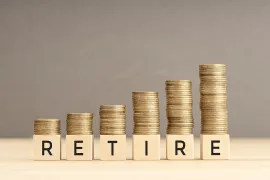Spectre of inflation adds to early retirement risk for this young B.C. couple
Tom and Charlene will have to depend on savings to make retirement work, expert says

Early retirement means that if inflation picks up, the company pension will lose purchasing power and interest rates will tend to rise.
A couple we’ll call Tom and Charlene, both 40, live in B.C. with their seven-year-old son Sam. They bring home $13,179 per month from their jobs in high tech plus additional income from a rental property. Tom has a defined-benefit pension, but retirement at 55, which is their goal, would mean a reduction in the annual payout. Their question is when to start retirement: the earlier they retire, the longer their will have to carry the risk that a rising cost of living will eat away at their buying power. For a retirement could last 35 years, that risk is substantial.
A couple we’ll call Tom and Charlene, both 40, live in B.C. with their seven-year-old son Sam. They bring home $13,179 per month from their jobs in high tech plus additional income from a rental property. Tom has a defined-benefit pension, but retirement at 55, which is their goal, would mean a reduction in the annual payout. Their question is when to start retirement: the earlier they retire, the longer their will have to carry the risk that a rising cost of living will eat away at their buying power. For a retirement could last 35 years, that risk is substantial.
The financial question is: Can they make their plan work and achieve their goal of $6,000 in minimum monthly income?
Family Finance asked Derek Moran, head of Smarter Financial Planning Ltd. in Kelowna, B.C., to work with Tom and Charlene.
Before going any further, the couple wants to ensure they have provided for post-secondary education for Sam. He has $30,000 in his RESP. The parents contribute $208 per month and receive the lesser of 20 per cent or $500 per year from the Canada Education Savings Grant to a $7,200 limit per beneficiary. Assuming three per cent annual growth of rising balances, at 17, when ready for post-secondary education, Sam will have $62,500. That’s sufficient for a four-year degree if he lives at home.

The financial base for retirement
To make retirement work with a start a decade before the usual start of CPP, OAS and company pensions, Tom and Charlene will have to depend on savings.They have $227,000 in GICs and $10,000 in cash they can use to add to RRSPs to reduce taxes and perhaps for reduction of their two major debts — $210,000 on their house and $638,000 on their rental.
For now, the couple’s net worth, $2,142,000, is excellent for their ages, Moran explains. They have sufficient savings to create tax-reduction opportunities. Each partner has unused RRSP room: $125,000 for Tom and $78,000 for Charlene. They should take $67,000 from their GIC and put it into Tom’s RRSP to cut his taxes. They can use the remaining $160,000 cash to pay down their $210,000 personal mortgage to just $50,000. Reamortize the home mortgage over 10 years to a small payment of $462 per month and divert $2,186 per month from the old $2,648 former amount to the RRSP.
Pension math
Tom’s work pensions will pay him $59,724 per year if he works until he turns 62, but every year before that will result in reductions, due both to having fewer years of work credit and the earlier start date. At 55, he would qualify for $25,060 per year, less than half of the age 62 level.The current maximum payout for CPP is $14,445 per year. The loss caused by quitting at 55, due to a reduction in years worked, a key part of the CPP formula, would be 15 per cent for Tom and 30 per cent for Charlene. That reduces their base age-65 CPP payments to $12,278 and $10,112, respectively.
Each partner will be able to take full Old Age Security, currently $7,707 per year, at 65.
The couple’s RRSPs have a present total of $140,000. A one-time contribution of $67,000 plus $2,186 per month growing at three per cent after inflation for 15 years to retirement would become $825,023 at age 55. If that sum is spent over the following 35 years, it would provide $37,278 pre-tax annual income, all in 2022 dollars.
The couple’s $168,000 TFSA balance plus $12,000 annual contributions growing at three per cent over the rate of inflation would become $491,620 at retirement in 15 years. That capital, spent over the following 35 years to their age 90 would generate $22,213 per year to the exhaustion of all income and capital.
Their $1.2 million rental is a dilemma. It produces rent of $5,000 per month. They have $562,000 equity and owe $638,000. Property tax, insurance and the interest on the mortgage cost them $18,311 per year. Their net rental income, $60,000 less costs, leaves them with a healthy $41,689 per year. They have a present seven per cent return on equity, which is excellent. If they are able to fully pay down the rental mortgage by 55 — it will be close — they would have no mortgage interest and therefore $50,812 annual net rent.
At 55, the couple would have $37,278 from RRSPs, $22,213 from TFSAs and $50,812 rent with mortgage paid and Tom’s $25,060 pension. That’s a total of $135,253. Assuming splits of eligible income, no tax on TFSA income and 19 per cent average tax, then with TFSA cash flow restored, they would have $9,480 to spend per month. At 65, they could add $12,712 and $10,112 from CPP and $7,707 per person from OAS, total $173,450. With splits, no tax on TFSA cash flow, and 20 per cent average tax they would have $11,935 per month to spend. Their target minimum retirement income, $6,000 per month, would be attained and would be sustainable. With no mortgage payment for home or rental and no RESP or TFSA savings, their costs would drop by $7,656 to $5,523 per month.
Risks
Early retirement means that if inflation picks up, the company pension will lose purchasing power and interest rates will tend to rise. We can’t predict inflation rates, but the risk to income is clear. Were Tom to work to 62, he could lock in a much larger annual pension payment, and mitigate those inflation risks.Retirement stars: 4 **** out of 5
Financial Post
( C) 2022 The Financial Post, Used by Permission

































